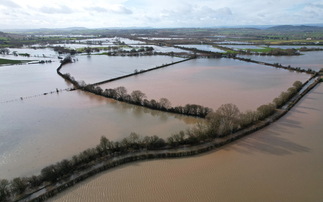Why all eyes will be on India at the Paris climate talks
Backed by strong clean energy targets and policies, India is poised to play a leading role on the upcoming climate change discussions in Paris this December. The federal government in India, led by Prime Minister Narendra Modi, has set a target of 175 GW renewable energy capacity (20 per cent in the total energy mix) by 2022, which will be vital to India's sustainable growth story.
India has many economic targets to achieve for which free and cheap energy is vital. India has the world's second largest population and fourth largest economy, with a per capita annual GDP of $1,630. While the Indian economy has been among the fastest growing in the world in the last two decades, the major part of this growth is due to the service sectors, including information technology, bio-technology, as well as media and entertainment.
The nation aims to reduce the poverty rate to 15 per cent, provide full employment, ensure food, energy and economic security and double per capita income. The ambition to achieve this target has increased India's emissions more than 65 per cent in the last 10 years. A large share of these greenhouse gases are emitted by the industrial sector (close to 41 per cent).
India, like many developing economies, took a strong "emit now and pay later" position at the Copenhagen Summit in 2009 but the approach to climate change is positively changing.
Indian political and business leaders are gradually realising that it is not in the country's interest to walk a carbon-intense growth path, especially because of its own climate vulnerabilities. There are reasons beyond economy and sustainability for why India must commit to a strong emissions cut plan ahead of the Paris summit.
India's trapped thermal deposits
India is the fourth largest producer and the second biggest consumer of coal. Its large coal deposits are trapped under its forest land. Exploring this untapped energy not only would result in additional emissions but also massive deforestation and subsequent marginalisation of the country's large tribal population. The growing number of violent revolts across Indian states with high mineral deposits is worrisome, and is likely to be exacerbated with increased coal exploration and production.
Vulnerable populations
The smallest climatic alterations, natural disasters or climate-induced epidemic affect the most populous, poorest and the marginalised first. India is the second most populous country in the world and is set to overtake China in 2030 (whose emissions are likely to peak in the same year). Air pollution causes eight million deaths every year in India. This is about 30 per cent of the total deaths globally due to air pollution, according to the World Health Organization's report on Health and Environment released in May.
Delhi, the world's most polluted city, recorded a whopping 300 per cent rise in respiratory illness cases between 2007-2008 and 2013-2014. India reported about 2,000 heat-related deaths in the summer of 2015. India's Minister of Science and Technology and Earth Sciences blamed the heat deaths squarely on climate change.
Under four degrees Celsius warming, the west coast and southern India are projected to shift to new, high-temperature climatic regimes with significant impacts on agriculture. In 1987 and 2002-2003, droughts affected more than half of India's crop area and led to a huge fall in crop production. Even without climate change, 15 per cent of India's groundwater resources are overexploited.
Rising mean sea level and India's long coastline
India's 7,517-kilometre coastline is highly vulnerable to climatic changes. The mean sea levels in South Asia are constantly rising. This is adversely affecting the coastal marine and plant lives. This also will immensely affect millions dependent on sea for a living.
India's financial nerve center, Mumbai, has the world's largest population exposed to coastal flooding, with large parts of the city built on reclaimed land. The city received the highest single-day rainfall of 994 millimeters in 2005, and subsequent flooding claimed over 1,000 lives. Many coastal cities have been receiving torrential rains and are finding it hard to tackle due to growing population and crumbling infrastructure.
Renewable energy - the only way forward
In India coal is used to power more than half of the country's electricity generation. In 2010, India introduced a nationwide carbon tax of $1 per metric tonne on coal and today it stands at $4 per metric ton. While a tax on carbon is the most direct method to systematically approach the greenhouse gas emission cuts, a small tax will not amount to any substantial reduction in emissions. The only way forward is to increase the share of renewable energy in total energy mix up to 25 per cent.
Currently, the share of renewables in India's energy mix is less than nine per cent. To meet its commitment to cut 25 per cent of emissions by 2020, India would need to achieve 90 GW renewable, hydro and nuclear energy capacity (about 20 per cent in the total energy mix). India has set an ambitious 2022 energy target, and aims to quadruple renewable capacity to 175 GW (100 GW from solar and 75 GW from wind and biomass). If opened up, this is likely to create an immediate opportunity worth $10.51 billion for the renewable market in India.
What is working in favor of solar energy is the fast-declining cost of power generation. The last few years have seen a dramatic decline in solar power costs in India, from 30 cents a unit to nearly nine cents. This has made the government perceive solar energy as an economically viable choice for the country. The government envisages an investment of around $100bn in the sector over the next seven years. This opens up the space for foreign investments, especially from China, Japan, Germany and the US and encourages indigenous manufacturing of solar components, which will create jobs and further alleviate poverty in India.
The Economic Survey report released in February claimed that if the set targets are met then India's renewable energy industry is likely to generate business opportunities worth $160bnn in the next five years.
Globally, the renewable sector has generated large employment opportunities. If India wants to take a high growth but low carbon path then a massive renewable energy plan is the only way forward. It is not just in the planet's interest but also in India's strategic, ecological and economic interest to envision a future which is sustainable and fueled by renewable energy.
Why India will matter at Paris
Strategically, the US and China are in an advantageous position. The two countries signed a landmark agreement to reduce emissions in November. While emissions from the US are poised to decline gradually over the next decade as a natural consequence of growth, technological advancements and addition of renewable capacities, all of which will be supported by President Barack Obama's recently announced plan to reduce emissions from US power plants; China has made commendable efforts in reducing its carbon emissions.
China is the largest importer of fossil fuels, including coal, and raw materials such as iron ore and cement that are essential for growth. Chinese developmental efforts have borne fruit and millions have broken free from poverty in the last decade. Although ambitious, China's targets are realistic. In 2013 China added about 100 GW of new capacity of which 58 percent came from renewable sources.
Therefore, all eyes will be on India in Paris and its role in reducing emissions while driving economic growth and improved standard of living for its citizens.
Vineet Mittal is vice chairman of Welspun Renewables
This article first appeared at GreenBiz








